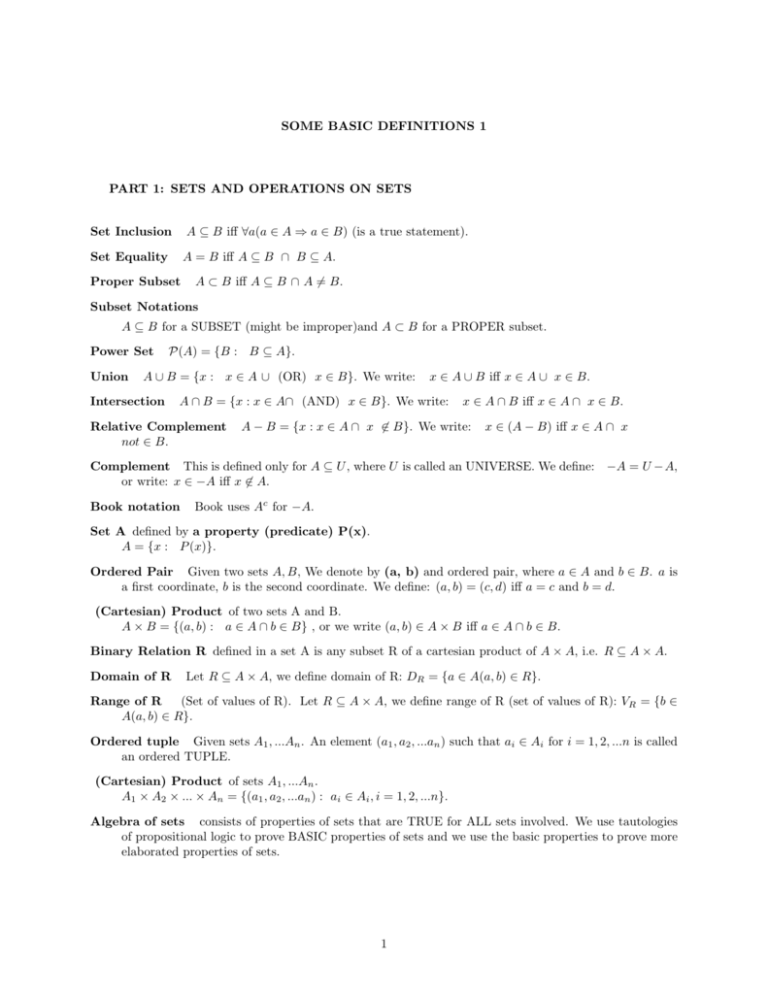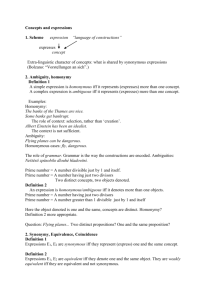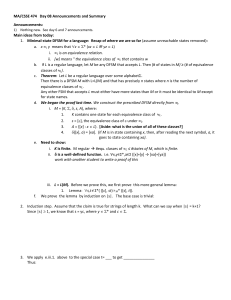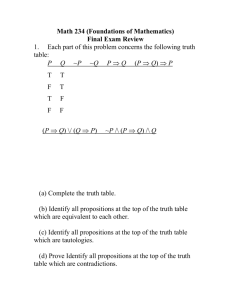Operations on Sets, Functions, Relations, Equivalence Relations
advertisement

SOME BASIC DEFINITIONS 1
PART 1: SETS AND OPERATIONS ON SETS
Set Inclusion
A ⊆ B iff ∀a(a ∈ A ⇒ a ∈ B) (is a true statement).
Set Equality
A = B iff A ⊆ B ∩ B ⊆ A.
Proper Subset
A ⊂ B iff A ⊆ B ∩ A 6= B.
Subset Notations
A ⊆ B for a SUBSET (might be improper)and A ⊂ B for a PROPER subset.
Power Set
Union
P(A) = {B : B ⊆ A}.
A ∪ B = {x : x ∈ A ∪ (OR) x ∈ B}. We write:
Intersection
x ∈ A ∪ B iff x ∈ A ∪ x ∈ B.
A ∩ B = {x : x ∈ A∩ (AND) x ∈ B}. We write:
Relative Complement
not ∈ B.
x ∈ A ∩ B iff x ∈ A ∩ x ∈ B.
A − B = {x : x ∈ A ∩ x 6∈ B}. We write:
x ∈ (A − B) iff x ∈ A ∩ x
Complement This is defined only for A ⊆ U , where U is called an UNIVERSE. We define: −A = U − A,
or write: x ∈ −A iff x 6∈ A.
Book notation
Book uses Ac for −A.
Set A defined by a property (predicate) P(x).
A = {x : P (x)}.
Ordered Pair Given two sets A, B, We denote by (a, b) and ordered pair, where a ∈ A and b ∈ B. a is
a first coordinate, b is the second coordinate. We define: (a, b) = (c, d) iff a = c and b = d.
(Cartesian) Product of two sets A and B.
A × B = {(a, b) : a ∈ A ∩ b ∈ B} , or we write (a, b) ∈ A × B iff a ∈ A ∩ b ∈ B.
Binary Relation R defined in a set A is any subset R of a cartesian product of A × A, i.e. R ⊆ A × A.
Domain of R
Let R ⊆ A × A, we define domain of R: DR = {a ∈ A(a, b) ∈ R}.
Range of R
(Set of values of R). Let R ⊆ A × A, we define range of R (set of values of R): VR = {b ∈
A(a, b) ∈ R}.
Ordered tuple Given sets A1 , ...An . An element (a1 , a2 , ...an ) such that ai ∈ Ai for i = 1, 2, ...n is called
an ordered TUPLE.
(Cartesian) Product of sets A1 , ...An .
A1 × A2 × ... × An = {(a1 , a2 , ...an ) : ai ∈ Ai , i = 1, 2, ...n}.
Algebra of sets consists of properties of sets that are TRUE for ALL sets involved. We use tautologies
of propositional logic to prove BASIC properties of sets and we use the basic properties to prove more
elaborated properties of sets.
1
PART 2: FUNCTIONS
Function as Relation
R ⊆ A × B is a FUNCTION from A to B iff
∀a ∈ A ∃! b ∈ B (a, b) ∈ R.
Where ∃! b ∈ B means there is EXACTLY one b ∈ B. Because for all a ∈ A we have exactly one
b ∈ B, we write it as: a = R(b) for (a, b) ∈ R.
A is called A DOMAIN of a function R and we write:
R : A −→ B to denote that R ⊆ A × B is a FUNCTION from A to B.
Function notation We denote relations that are functions by letters f, g, h,... and write f : A −→ B
to say that f ⊆ A × B is a function from A to B (MAPS A into B).
Domain, codomain of f
f,
Graph of f
f (a)}.
Let f : A −→ B, A is called a DOMAIN of f and B is called a codomain of
In our approach the GRAPH and the function are the same. GRAP Hf = f = {(a, b) : b =
onto
ONTO function
f : A −→ B iff ∀b ∈ B∃a ∈ A f (a) = b.
1-1 function
f : A −→ B is called a ONE-TO ONE function and denoted by
1−1
f : A −→ B iff ∀x, y ∈ A(x 6= y ⇒ f (x) 6= f (y) ).
f is NOT 1-1
1-1, onto
f : A −→ B is not a ONE-TO ONE function iff ∃x, y ∈ A(x 6= y ∩ f (x) = f (y) ).
If F is a 1-1 and onto function we write it as f : A
1−1,onto
−→
B.
Composition Let f : A −→ B and g : B −→ C, we define a new function h : A −→ C, called a
COMPOSITION of f and g, as follows: for any x ∈ A, h(x) = g(f (x)).
Composition notation We denote a composition h of f and g as h = g ◦ f . I.e. we define:
for all x ∈ A, (g ◦ f )(x) = g(f (x)).
Inverse function
Let f : A −→ B and g : B −→ A.
g is called an INVERSE function to f iff ∀a ∈ A(g ◦ f )(a) = g(f (a) = a).
Inverse function notation
Identity function
If g is an INVERSE function to f we denote by g = f −1 .
I : A −→ A is called an IDENTITY on A iff ∀a ∈ AI(a) = a.
Inverse and Identity
Let f :
A −→ B and f −1 :
B −→ A is an inverse to f. Then
(f −1 ◦ f )(a) = I(a) = a, for all a ∈ A and (f ◦ f −1 )(b) = I(b) = b for all b ∈ B.
PART 3: SEQUENCES, GENERALIZED UNION AND INTERSECTION
Sequence
of elements of a set A is any function f : N −→ A or f : N − {0} −→ A.
n-th term of a sequence
Let f : N −→ A be a sequence, an = f (n) is called a n-th term of a
sequence f and we write the sequence f as a0 , a1 , ...an , .....
Sequence notation
Let f be a sequence, we denote it as {an }n∈N , or {an }n∈N −{0} .
2
Finite Sequence of elements of a set A is any function f : {1, 2, ...n} −→ A, and n is called LENGTH
of the sequence f. We usually list elements of the finite sequences: a1 , ...an .
Family of sets
Any collection of sets is called a Family of sets. We denote it by F.
Sequence of sets
is a sequence f : N −→ F, i.e asequence where all its elements are SETS. We
use CAPITAL letters to denote the sets, so we also use capital letters to denote sequences of sets:
{An }n∈N , or {An }n∈N −{0} .
S
Generalized
n∈N An = {x : ∃n ∈ N x ∈ An }, i.e.
S Union of a sequence of sets:
x ∈ n∈N An iff ∃n ∈ N x ∈ An .
T
Generalized
n∈N An = {x : ∀n ∈ N x ∈ An }, i.e.
T Intersection of a sequence of sets:
x ∈ n∈N An iff ∀n ∈ N x ∈ An .
Indexed Family of Sets Let F be a family of sets, and T 6= ∅. Any f : T −→ F, f (t) = At is called
an indexed family of sets, T is called a set if indexes. We write it: {At }t∈T .
NOTICE that any sequence of sets is an indexed family of sets for T = N .
S
Generalized
t∈T At = {x : ∃t ∈ T x ∈ At }, i.e.
S Union of an indexed family of sets:
x ∈ t∈T At iff ∃t ∈ T x ∈ At .
T
Generalized
t∈T At = {x : ∀t ∈ T x ∈ At }, i.e.
T Intersection of an indexed family of sets:
x ∈ t∈T At iff ∀t ∈ T x ∈ At .
Generalized
S Union of any family F of sets:
x ∈ F iff ∃S ∈ F x ∈ S.
S
F = {x : ∃S ∈ F x ∈ S}, i.e.
Generalized
T Intersection of any family F of sets:
x ∈ F iff ∀S ∈ F x ∈ S.
T
F = {x : ∀S ∈ F x ∈ S}, i.e.
PART 4: IMAGE AND INVERSE IMAGE
Image of a set A ⊆ X under a function f : X −→ Y . NOTATIONS: f (A) or f → (A). Definition:
f (A) = f → (A) = {y ∈ Y : ∃x(x ∈ A ∩ y = f (x))}, i.e.
y ∈ f (A)
iff ∃x(x ∈ A ∩ y = f (x)).
Inverse Image of a set B ⊆ Y under a function f :
Definition:
X −→ Y . NOTATIONS: f −1 (B) or f ← (B).
f −1 (B) = f ← (B) = {x ∈ X : f (x) ∈ B}, i.e.
x ∈ f −1 (B)
iff f (x) ∈ B.
PART FIVE: EQUIVALENCE, PARTITION
Equivalence relation
R ⊆ A×A is an equivalence relation in A iff it is relexive, symmetric and transitive.
Equivalence relation symbols We denote equivalence relation by ∼, or ≈, or ≡. In my notes we usually
use ≈ as a symbol for the equivalence relation.
Equivalence class If ≈ ⊆ A × A is and equivalence relation then the set E = {b ∈ A : a ≈ b} is called
an equivalence class.
3
Equivalence class symbols
The equivalenve classes are usually denoted by:
[a] = {b ∈ A : a ≈ b}
and the element a is called a representative of the equivalenve class [a] = {b ∈ A : a ≈ b}.
Other symbols used are: |a| or k a k for the eaquivalence class {b ∈ A : a ≈ b} with representative a.
Partition
A family of sets P ⊆ P(A) is called a partition of the set A iff the following conditions hold.
1. ∀ X ∈ P (X 6= ∅)
i.e. all sets in the partion are non-empty.
2. ∀ X, Y ∈ P (X ∩ Y = ∅)
i.e. all sets in the partion are disjoint.
S
3.
P=A
i.e sum of all sets from P is the set A.
A/ ≈
A/ ≈ denotes the set of all equivalence classes of ≈, i.e.
A/ ≈= {[a] : a ∈ A}.
Equivalence and Partition
We prove the following theorem:
Let A 6= ∅, if ≈ is an equivalence relation on A, then A/ ≈ is a partition of A, i.e.
1. ∀ [a] ∈ A/ ≈ ([a] 6= ∅)
i.e. all equivalence classes are non-empty.
2. ∀ [a] 6= [b] ∈ A/ ≈ ([a] ∩ [b] = ∅)
i.e. all equivalence classes are disjoint.
S
3.
A/ ≈= A
i.e sum of all equivalence classes (sets from A/ ≈) is the set A.
Partition and Equivalence
We prove also a following:
For partition P ⊆ P(A) of A, there is an equivalence relation on A such that its equivelence classes
are exactly the sets of the partition P.
Sets R(a)
Observe that we can consider, for ANY relation R on A sets that ”look” like equivalence
classes i.e. are defined as follows:
R(a) = {b ∈ A; aRb} = {b ∈ A; (a, b) ∈ R}.
R(a) Fact 1
If R is an equivalence on A, then the family {R(a)}a∈A is a partition of A.
R(a) Fact 2
If the family {R(a)}a∈A is NOT a partition of A, then R is NOT an equivalence on A.
4








